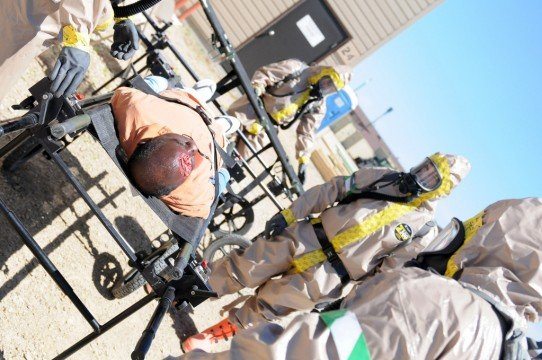About 40,000 National Guard members working with active duty servicemembers and federal and state emergency personnel completed “National Level Exercise 11” on May 20, 2011, signaling the successful execution of the largest interagency exercise ever, Guard officials said.
The exercise, based around the New Madrid Seismic Zone and with an earthquake of disastrous magnitude as the scenario, tested the response capabilities of the Alabama, Arkansas, Illinois, Indiana, Kentucky, Mississippi, Missouri, Tennessee and Wisconsin National Guards.
“National Level Exercise 11”, or NLE 11, incorporated several other exercises, to include the Joint Chiefs of Staff Positive Response 2011, U.S. Northern Command’s Ardent Sentry 2011, the Department of Health and Human Services Noble Life Saver 2011, the National Guard’s Vigilant Guard and U.S. Transportation Command’s Turbo Challenge 2011/Ultimate Caduceus 2011.
Each state worked with their current emergency response plan to find strengths and weakness, said Army Maj. Gen. David Harris, the National Guard Bureau’s director of domestic operations and force development.
Harris said issues brought to light by exercises like NLE 11 — such as organization and staffing — can be solved quickly, but others – such as communication package and hardware issues – take a little more planning and budgeting to fix.
“That’s why exercises like this are important, to show those potential shortfalls,” Harris said.
Alabama Guard members provided aerial support for infrastructure assessments, basic first aid and medical triage and security support in several counties.
Like several states, they activated their chemical, biological, radiological, nuclear and high yield explosives, or CBRNE, enhanced response force package, also known as CERFP, for search and rescue and mass casualty support.
The Arkansas Guard had engineering teams providing damage assessment and repairing damaged airport runways.
They also filled about 50,000 sand bags for potential flooding, provided enough shelters for about 4,500 displaced citizens and delivered cots, blankets and relief goods.
In Illinois, Guard members assisted local law enforcement with public safety and welfare checks in rural areas.
They had several civil support teams, or CSTs, responding to a simulated biohazard emergency where about 15,000 gallons of soybean oil leaked into the Ohio River.
Indiana made the NLE 11 an opportunity to practice with their 53rd CST and worked with first responders from various Indiana Department of Homeland Security districts on emergency response procedures.
As part of their full-time mission set, the 53rd CST responds to chemical, biological, radiological or nuclear incidents and works with local first-responders to determine the type of attack or incident.
Kentucky took the opportunity to bring past experiences to the table for the purposes of updating and rewriting their Commonwealth Earthquake Response plan.
“We learn something with each event or disaster, such as the historic flooding Kentucky just experienced,” said John Heltzel, director for Kentucky Emergency Management. “The trick is to take lessons learned and turn them into lessons applied.”
The Kentucky Joint Air Operations Center,or JOAC, also worked to prioritize and allocate air assets for missions across the Commonwealth.
They transported personnel and equipment, and provided aeromedical evacuation and search-and-rescue capabilities when needed, said Air Force Brig. Gen. Mark Kraus, who commands the JAOC and is Kentucky’s Joint Forces Air Component commander.
Missouri Guard members provided CBRNE agent monitoring and mitigation and decontamination, emergency medical services and extraction at collapsed structures.
“The Missouri National Guard is a key component of disaster response,” said John Campbell, of the State Emergency Management Agency, who is also a retired Missouri National Guard master sergeant.
“The Guard brings capabilities that don’t exist in everyday situations,” he said. “They bring disciplined citizen Soldiers and Airmen to check the well being of folks who are suffering from the effects of a disaster or to provide warnings.”
The Mississippi Guard’s 4th CST worked with Florida, Georgia and Texas CERFPs providing search and extraction and mass casualty support in a simulated hazardous environment.
Tennessee had Guard members establishing communication lines at the county level, providing security and shelters for citizens, and provided aviation support for damage assessments.
The Wisconsin National Guards 54th CST supported local and state authorities at domestic emergency incident sites. They worked to identify substances and assess current and projected consequences.
“The CST provided safety of the scene, data modeling, communications and liaison between the incident commander and public health authorities,” said Lt. Col. Timothy Covington, commander. “This was a great opportunity to introduce our capabilities to local agencies and to show how those resources might be used in the event of a large-scale disaster.”
NLE 11 also allowed Guard members and NORTHCOM to practice their developed Contingency Dual Status Command initiative.
During a natural or man-made disaster, the initiative allows a commissioned officer of the regular Army or regular Air Force or state Army National Guard or Air National Guard to command and control state and federal military assets in a Defense Support of Civil Authorities environment, NORTHCOM officials said.
With the completion of NLE 11, relationships were solidified with the Federal Emergency Management Agency, Nuclear Regulatory Commission, Transportation Security Administration and several more federal and state agencies.
Such relationships will allow the Guard and determine areas of responsibility throughout the individual states in the event of a real-world catastrophic event, Guard officials said.










